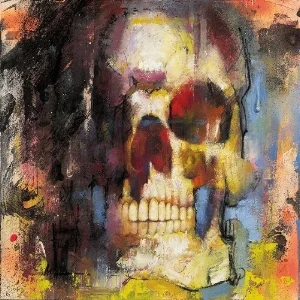Shane Guffogg Essay
The "Catalyst" for Circle of Truth Project
#1 Shane Guffogg (Response Painting)
I began a search for my idea of truth by reflecting on a long-time interest of mine. I have spent many years reading about ancient civilizations as a way of understanding who we were and how we got here. My elementary through high school education was never something I trusted, because I intuitively knew I was being told the story from the side that won, and there was another side to the story. Without knowing both sides, I could never know the truth. Another factor in all this history of the world stuff was the ancient stone structures, made with such precision that we still can't achieve the same results today. They were created from monolithic stones that were supposedly chiseled to an arithmetical perfection. It got me really wondering about how this was possible. I only bring this up because this self-imposed reading adventure led me to the Golden Mean, the mathematical ratio of 1:1.618, also known as the Golden Section, Golden Ratio, Divine Proportion, and the Greek Phi, symbolized as a circle with a capital “I” running through its center. This was the same symbol I based the Pharmaka logo on, but I replaced the “I” with a paintbrush, and painted it with sumi ink. Just one of the little coincidences life occasionally likes to serve up.
But the Golden Mean is the mathematical code of nature that gives the flower the instructions on how to grow its petals, or the ratio of the inner part versus the outer part of water as it goes down a drain. It is the same ratio up in the sky that we can see on a clear night—the way the solar systems revolve around the center of the Milky Way Galaxy. It is a mathematical truth of our visible universe, and the ancient peoples of the world knew this and considered this ratio sacred. The architectural designs of ancient stone structures all over the world are based on this number. And so are the proportions of the human body and face. The distance between the eyes, the length of the forehead, the nose, and how they all relate to all the other parts of the face are all proportioned by 1:1.618. Mathematicians say that math is truth and that the Golden Mean is the architectural truth of our universe. You can see where I am going with this by now. My idea of truth was the only “known” truth in the universe: the Golden Ratio. I found an image online of how the human face is divided up into squares and rectangles by this number
and used this as a template, painting the largest square white and the others the primary colors (red, yellow and blue). Where the squares or rectangles touched, those primary colors were blended to become secondary colors (green, orange and purple).
There it was—a simple, to-the-point, non-representational painting, using oil on linen, encoded with a number that has built empires, inspired artists throughout the ages, and created musical masterpieces. All of these have, in one way or another, enabled us to recognize what it means to be human. After all was said and done, that was my truth I kicked off this project with.













































